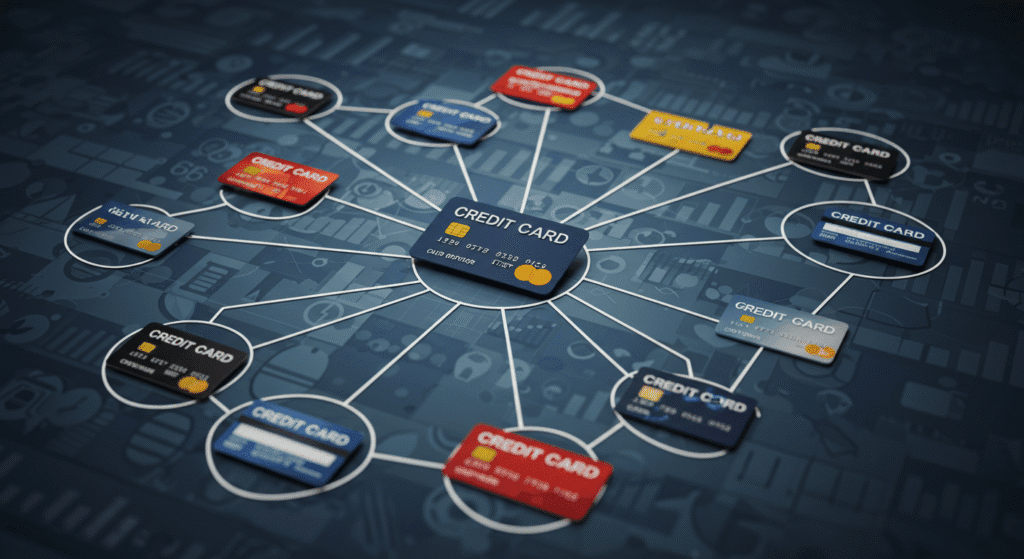
Manage Them Wisely
Credit cards are fascinating tools. On one hand, they offer unparalleled convenience, are essential for online transactions and travel, provide a safety net in emergencies, and can unlock valuable rewards like cashback, travel points, and exclusive perks. They are also fundamental building blocks of your financial reputation – your credit score.
On the other hand, they represent the easiest way to fall into crippling debt, incur high-interest charges and fees, and feel overwhelmed by financial obligations. They are, in essence, a powerful financial lever – capable of lifting you up or burying you, depending entirely on how you wield them.
This inherent duality is why the simple question, “How many credit cards should I have?” is anything but simple. You’ll hear wildly different answers depending on who you ask. Some preach minimalism – “Just one, maybe two, to keep it simple!” Others advocate for optimization – “As many as you can manage to maximize rewards and credit building!”
So, who’s right? Is there a magic number? A universal truth that applies to everyone from the financially savvy points hacker to someone just starting their credit journey?
From my perspective, having navigated the world of credit cards for many years – experiencing both the benefits of strategic use and the anxieties that come with potential pitfalls – the answer is clear: there is no single “right” number. The optimal number of credit cards, and more importantly, how you should manage them, is deeply personal and depends entirely on your individual financial habits, goals, discipline, and capacity for organization.
But while the number is flexible, the principles of managing them wisely are not. Let’s explore this balancing act, drawing on my personal experience and backing it up with the objective data that governs how credit cards impact your financial health.
My Personal Journey with Credit Cards: From One to… Several
I remember getting my first credit card like it was yesterday. It felt like a rite of passage into adulthood, a small piece of plastic representing trust and responsibility. Like many beginners, I started with just one. My focus was simple: use it sparingly, pay the minimum balance (a mistake I quickly learned from), and build credit.
Over time, as my financial understanding grew and my income increased, the number of cards in my wallet began to multiply. It wasn’t a conscious goal to collect plastic, but rather a response to evolving needs and opportunities. A card with better rewards for groceries here, a card offering travel points for flights there, sometimes opening one just for a tempting sign-up bonus (a strategy that requires careful execution).
Suddenly, I went from having one card to three, then five, and at one point, close to ten actively used credit cards. This wasn’t because I was overspending (a constant, vigilant effort to avoid), but because I was trying to segment my spending to maximize rewards and manage different types of expenses. Business expenses went on one card, everyday purchases on another optimized for cashback, large planned purchases sometimes went on a card with 0% intro APR (paid off before the period ended, of course).
This multiplication of cards brought both benefits and new challenges. On the one hand, I was earning significant rewards – cashback that helped offset expenses or points that funded travel I wouldn’t have otherwise taken. My overall available credit increased dramatically, which, as we’ll see in the data, can be beneficial for my credit score if managed correctly.
On the other hand, managing multiple cards required a new level of organization. Different due dates, varying reward structures, different online portals, annual fees to track. There was a quiet anxiety that came with knowing I had several lines of credit open – a constant reminder of the potential for disaster if my discipline ever wavered. I had to develop robust systems to ensure I never missed a payment and always paid the full balance.
This personal evolution led me to realize that the question isn’t merely “how many cards,” but “how many cards can you responsibly manage while aligning with your financial goals?”

The “How Many” Question: It’s Not a Magic Number (But Data Provides Clues)
Let’s directly address the number. Is there a universally agreed-upon ideal? No. Financial experts and consumer advocates rarely put a hard limit on the number of cards. Instead, they focus on the behavior associated with having credit.
For a beginner, starting with one or two cards is often recommended. It allows you to learn the ropes, understand billing cycles, payment due dates, and how interest accrues, without being overwhelmed. Successfully managing one or two cards builds a solid foundation.
For someone with established credit and strong financial discipline, having several cards – potentially five, eight, or even more – might make sense from a strategic perspective, primarily to maximize rewards or leverage specific card benefits.
The objective data that supports this nuance comes from how credit bureaus calculate your credit score. While having too many applications in a short period or having too many cards you cannot manage negatively impacts your score, simply possessing multiple cards, if managed well, is not inherently bad for your credit score; in fact, it can be beneficial.
Objective Data: How Credit Cards Impact Your Credit Score
Your credit score is a three-digit number that lenders use to assess your creditworthiness. It impacts your ability to get loans (mortgages, car loans), the interest rates you pay, and even things like renting an apartment or getting insurance. Multiple credit cards interact with the key factors that make up your score:
- Payment History (Approx. 35% of score): This is the single most important factor. Paying your bills on time, every time, is paramount. Having multiple cards means having multiple due dates to track. Missing a single payment on any card can significantly ding your score and trigger late fees and penalty interest rates. Data consistently shows missed payments are the most detrimental action to your credit.
- Amounts Owed / Credit Utilization Ratio (Approx. 30% of score): This is the second most important factor. It’s calculated by dividing the total amount of credit you’re using across all your cards by your total available credit limit. For example, if you have $5,000 charged across all cards and your total combined limit is $10,000, your utilization is 50%. Data shows that keeping your credit utilization low is crucial for a good score. Experts generally recommend keeping it below 30%, and ideally below 10%.
- How multiple cards help: Having multiple cards, assuming you qualify for reasonable limits on each, increases your total available credit. If you maintain your spending level while increasing your total available credit, your utilization ratio decreases. For instance, if you have one card with a $5,000 limit and a $1,000 balance (20% utilization), opening a second card with a $5,000 limit (total available credit now $10,000) without increasing your spending ($1,000 total balance) reduces your utilization to 10%. This is a significant benefit of having multiple cards if you don’t let increased credit lead to increased debt.
- Length of Credit History (Approx. 15% of score): This considers the age of your oldest account, the age of your newest account, and the average age of all your accounts. Keeping old, unused credit card accounts open (as long as they don’t have annual fees that outweigh the benefit or pose a temptation risk) can help increase your average account age over time, positively impacting this factor. Opening many new cards in a short period will lower your average age temporarily.
- Credit Mix (Approx. 10% of score): Having a mix of credit types, like revolving credit (credit cards) and installment loans (mortgage, car loan), can be slightly positive. Having multiple credit cards contributes positively to your revolving credit mix.
- New Credit (Approx. 10% of score): Opening several new credit accounts in a short period can slightly lower your score. Each time you apply for credit, a “hard inquiry” appears on your report, which can shave a few points off your score temporarily. The impact is usually small and fades over time, but applying for many cards simultaneously is generally not advisable unless you have a specific strategy (like applying for multiple cards from different issuers on the same day for a large purchase or reward goal, although the effectiveness and impact of this strategy vary and are debated).
Synthesizing this data: From a purely credit score perspective, having multiple credit cards can be advantageous because it increases your total available credit, making it easier to maintain a low credit utilization ratio, provided you keep balances low and pay on time. However, the increased complexity significantly raises the risk of missing payments or falling into debt, which would severely damage your score – far outweighing any benefit from utilization.
Why People Have Multiple Credit Cards (The “Why” Behind the Wallet Full of Plastic)
So, beyond the theoretical credit score impact, why do people choose to manage multiple cards?
- Rewards Optimization: This is the primary driver for many. Different cards offer better rewards on specific spending categories (e.g., 5% back on groceries, 3% on gas, 2% on dining, 1.5% on everything else). By strategically using the right card for the right purchase, you can significantly maximize your rewards earnings compared to using just one general rewards card. Travel cards offer points or miles that can lead to free flights and hotel stays, often with lucrative sign-up bonuses that encourage opening new accounts.
- Building Credit History: While one card is enough to start, successfully managing multiple cards over time demonstrates to lenders that you can handle various lines of credit responsibly, potentially making you a more attractive borrower for larger loans later.
- Emergency Fund/Buffer: Credit cards can serve as a crucial emergency fund, providing access to funds for unexpected expenses (medical bills, car repairs) when cash reserves are low. Having multiple cards increases the total available credit for such situations (though relying solely on credit for emergencies is risky).
- Separating Spending: For budgeting or tax purposes, having separate cards for different categories (e.g., business vs. personal, or even specific hobbies) can simplify tracking expenses.
- Specific Benefits: Many cards offer benefits beyond rewards, such as purchase protection, extended warranties, travel insurance, car rental insurance, lounge access, or access to exclusive events. Having multiple cards allows you to access a wider range of these perks.
- Balance Transfers: While a strategy to be used with extreme caution and discipline, opening a card with a 0% introductory APR on balance transfers can be a way to consolidate and pay down high-interest debt faster, effectively using a new card as a tool to manage existing debt (though this is a high-risk maneuver if the underlying spending habits aren’t addressed).
The Risks of Having Too Many Cards (The Slippery Slope)
For every potential benefit of multiple cards, there’s a corresponding risk. The dangers are significant and often outweigh the rewards for those who lack strict discipline or organization.
- Increased Risk of Debt: This is the most obvious and severe risk. A higher total credit limit can feel like permission to spend more. The temptation to carry a balance becomes greater, leading to exorbitant interest charges that quickly negate any rewards earned. Falling into minimum-payment cycles can turn small balances into mountains of debt over time, a trap that data shows is incredibly hard to escape.
- Difficulty Tracking Payments: Juggling different due dates across multiple cards is a recipe for disaster for many people. A single missed payment triggers late fees and negatively impacts your credit score for years. While automation helps (and is essential, as discussed below), relying solely on memory or manual tracking with many cards is highly risky. I’ve had close calls myself before I fully automated my system.
- Annual Fees Adding Up: Many premium rewards cards come with annual fees, sometimes exceeding $100, $250, or even $500+. While the rewards and benefits can justify these fees if fully utilized, having multiple cards with annual fees requires careful annual assessment to ensure you’re getting more value than you’re paying. It’s easy to accumulate fees on cards whose benefits you no longer fully use.
- Complexity of Management: Beyond due dates, you have to track different online portals, understand varying reward structures (which can change), and manage login information. This complexity can be overwhelming and lead to mistakes.
- Potential for Fraud: Each card is a potential point of exposure for fraud. While card companies offer protection, dealing with fraudulent charges across multiple accounts can be a time-consuming hassle.
- Impact of Closures: While closing a card you opened recently isn’t ideal for your credit age, closing an old, unused account can significantly lower your average account age. Also, if an issuer closes your account (due to inactivity, or worse, late payments on other cards), your total available credit drops instantly, potentially spiking your utilization ratio even if your balances haven’t changed – a frustrating data point to see impact your score.

How to Manage Credit Cards Wisely (Whether You Have One or Ten)
Given the risks and rewards, the emphasis must shift from how many cards to how well you manage them. Here are the principles and actionable steps I follow, based on personal experience and objective financial wisdom:
- Know Your Spending Habits & Discipline Level (Data Point: Self-Awareness is Key): Be brutally honest with yourself. Are you prone to impulse purchases? Do you struggle with budgeting? If so, having multiple cards with high limits is like giving a child too many cookies – the temptation might be too great. Start small, build discipline, and only consider more cards if you prove you can consistently control spending. Financial data consistently shows that out-of-control spending is the #1 driver of debt, regardless of the number of cards.
- Automate Payments (Data Point: Non-Negotiable for Credit Score): This is the golden rule, especially with multiple cards. Set up automatic payments for at least the minimum amount on every card through your bank account. Better yet, set up automatic payments for the full statement balance. This ensures you never miss a due date, protecting the most important factor in your credit score and avoiding late fees. Missing one payment can drop a good score by 50-100 points or more.
- Pay Balances in Full, Every Month (Data Point: Avoid Interest, Maximize Rewards): If you are carrying a balance and paying interest, you are doing credit cards wrong. The interest charges (often 15-25% or more) will quickly dwarf any rewards you earn. The objective is to use credit as a convenient payment tool, not a loan. Always pay the full statement balance by the due date. Data shows that carrying a balance is the fastest way to financial trouble with credit cards.
- Understand and Leverage Reward Structures (Data Point: Maximize Financial Benefit): If you have multiple rewards cards, know which one offers the best return for different types of purchases. Use a spreadsheet, a budgeting app, or simply label the cards. Use the right tool for the right job to maximize your cashback or points earnings. Objective analysis of card benefits vs. spending habits is key here.
- Regularly Review Statements (Data Point: Detect Fraud/Errors): Don’t just pay the bill; review every statement line item. Check for errors, unauthorized charges, or potential fraud. The sooner you catch these, the easier they are to dispute.
- Keep Track of Due Dates and Credit Limits (Data Point: Manage Utilization): While automation handles payment, you still need awareness. Use a calendar, a budgeting app, or a simple spreadsheet to track due dates and monitor your spending relative to your credit limits. This helps you manage your credit utilization ratio effectively across all cards.
- Be Mindful of Annual Fees (Data Point: Cost vs. Benefit Analysis): If a card has an annual fee, put a reminder on your calendar a month before it hits. Honestly assess if the rewards and benefits you received over the past year justified that fee. If not, call the issuer to see if they can offer a retention bonus or downgrade the card to a no-annual-fee version. Canceling should be a last resort, done carefully to consider the impact on your overall available credit and average account age.
- Use Each Card Periodically (Data Point: Prevent Account Closure): Credit card issuers may close inactive accounts. To prevent this (which can lower your total available credit and impact your score), use each card at least once every few months for a small purchase (like a coffee) and pay it off immediately.
- Monitor Your Credit Score (Data Point: Track Progress): Use the free credit monitoring tools offered by many card issuers or third-party services. Watching your score helps you see the impact of your management habits (good or bad) and alerts you to potential issues.
- Have a Strategy for New Applications (Data Point: Minimize Negative Impact): If you plan to apply for a significant loan (like a mortgage) in the next 6-12 months, avoid opening new credit cards, as the hard inquiries and reduced average age can slightly lower your score temporarily. Apply for new cards strategically, understanding the short-term impact.
My Current Strategy and Number (What Works For Me Right Now)
Today, I maintain around three actively used credit cards. This number works for me because it allows me to effectively segment my spending to maximize rewards across different categories (groceries, travel, business) while being a number I can realistically manage with automated payments and a simple tracking system. It also ensures I have a high total available credit limit, which helps keep my credit utilization ratio very low, contributing positively to my credit score.
This number isn’t static; it fluctuates slightly over time as I might open a new card for a specific travel goal or close/downgrade one if the benefits no longer justify an annual fee. The key is that each card serves a specific purpose in my overall financial strategy, and I have the systems and discipline in place to manage them responsibly.
Pertinent Information: Beyond the Basics
A few other points are worth noting:
- Store Cards/Retail Cards: While offering immediate discounts, these often have high interest rates and rewards that are only useful at that specific store. Evaluate if the benefit is worth the potential hit to your average credit age when opened and the temptation of a high APR.
- Secured Credit Cards: If you have no credit history or bad credit, a secured card (requiring a cash deposit as collateral) is an excellent tool to build or rebuild credit. Start here before considering multiple unsecured cards.
- Business Credit Cards: If you have a business, using a separate business credit card is crucial for tracking expenses and separating personal and business finances. These often have different reporting standards to credit bureaus.
- Authorized Users: Adding someone as an authorized user on your well-managed card can help them build credit, but your usage impacts their score, and their usage (if not paid for) impacts yours.
- Psychology of Rewards: Be aware that the excitement of earning rewards can subtly encourage overspending. Ensure you’re not buying things you don’t need just to earn points.
In the end, the question of “how many credit cards should one have” doesn’t have a one-size-fits-all answer. For someone who values simplicity or struggles with discipline, one or two might be the absolute maximum. For someone disciplined and seeking to optimize rewards or specific benefits, a larger number might be perfectly manageable and financially advantageous.
The objective data shows that having multiple cards can be good for your credit score by increasing total available credit, but it dramatically increases the risk of late payments and accumulating debt, which are far more damaging.
Therefore, the truly critical question isn’t how many cards you have, but how wisely you manage the ones you do have. Consistent on-time payments, keeping utilization low, avoiding interest, and understanding your goals are the cornerstones of responsible credit card use, regardless of the number of pieces of plastic in your wallet.
So, let me turn the question to you, informed by my own journey and the data we’ve discussed:
Considering your own financial habits and goals, what does responsible credit card management look like for you, and how many cards do you feel you can manage effectively to support that?
Disclaimer: This article was written from a personal perspective and reflects the author’s own opinions and experiences. It includes general information about credit cards and credit scores based on publicly available data. It is not financial advice, and individuals should conduct their own thorough research and consult with a qualified financial advisor before making any financial decisions.







